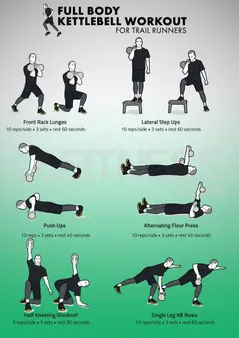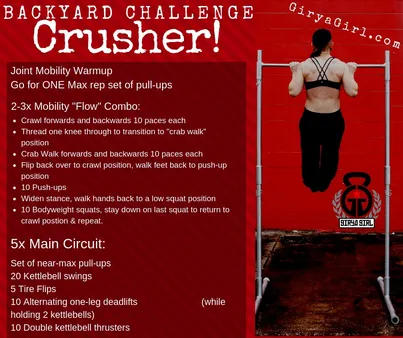Table of Contents
Kettlebells are a versatile piece of fitness equipment that can be used for a variety of exercises, including calisthenics. calisthenics kettlebell workouts are a great way to build strength, endurance, and flexibility. They are also relatively easy to learn and can be done anywhere, making them a great option for people who are new to exercise or who have limited time. If you are looking for a challenging and effective way to get in shape, calisthenics kettlebell workouts are a great option. Check out our website Kizworld.com for more information on calisthenics kettlebell workouts.
Calisthenics Kettlebell: The Ultimate Guide to Building Strength and Power
Benefit | Description |
|---|---|
Improved strength | Calisthenics kettlebell exercises challenge your muscles in new ways, helping you build strength and power. |
Increased endurance | The dynamic movements of calisthenics kettlebell workouts help improve your cardiovascular fitness and endurance. |
Enhanced flexibility | Calisthenics kettlebell exercises require a wide range of motion, which can help improve your flexibility and mobility. |
Reduced risk of injury | Calisthenics kettlebell exercises are low-impact and can help improve your posture and balance, reducing your risk of injury. |
Increased calorie burn | Calisthenics kettlebell workouts are a great way to burn calories and lose weight. |
I. Benefits of a Calisthenics Kettlebell Routine
Improved Strength and Endurance
Calisthenics kettlebell exercises challenge your muscles in new ways, helping you build strength and power. The dynamic movements of calisthenics kettlebell workouts also help improve your cardiovascular fitness and endurance.
How to build muscle and strength with calisthenics | |
|---|---|
Discover the secrets of building muscle and strength with calisthenics: techniques, workouts, and tips for maximum results. |
Enhanced Flexibility and Reduced Risk of Injury
Calisthenics kettlebell exercises require a wide range of motion, which can help improve your flexibility and mobility. These exercises are also low-impact and can help improve your posture and balance, reducing your risk of injury.
- How to improve your posturekizworld.vn
- Find the best calisthenics mats and blockskizworld.vn
- Try calisthenics and flexibilitykizworld.vn
Benefits of a Calisthenics Kettlebell Routine
II. Effective Calisthenics Kettlebell Exercises
Master the Basics
Mastering the calisthenics kettlebell basics is key to performing more advanced exercises safely and effectively. Start with compound movements that target multiple muscle groups simultaneously. These include squats, push-ups, rows, and swings. Ensure proper form by engaging your core and maintaining a neutral spine throughout every movement.
Exercise | Benefits | Muscles Targeted |
|---|---|---|
Calisthenics Kettlebell Swing | Improves explosive power, hip hinge mechanics, and cardiovascular endurance | Glutes, hamstrings, quads, back, shoulders |
Calisthenics Kettlebell Goblet Squat | Builds lower body strength and stability, promotes knee and ankle mobility | Quads, hamstrings, glutes, core |
Calisthenics Kettlebell Push-Up | Enhances upper body strength, builds chest and triceps mass, improves posture | Chest, triceps, shoulders, core |
Calisthenics Kettlebell Row | Strengthens back and improves shoulder mobility and posture | Back, biceps, shoulders, forearms |
Challenge Yourself with Progressions
As you gain strength, consider incorporating progressions to challenge yourself. These include variations like the one-leg kettlebell swing, archer push-up, and renegade row. These exercises demand greater stability, coordination, and core activation, providing an effective full-body workout. Always prioritize correct form over speed or weight.
Related Post: The Best Calisthenics Exercise and Variations
Incorporate Dynamic Movements
Dynamic calisthenics kettlebell exercises add an extra element of athleticism to your workouts. Plyometric exercises like kettlebell snatches and burpees improve power output and coordination. These exercises require explosive movements, often involving jumping or hopping, and engage multiple muscle groups.
- Calisthenics Kettlebell Snatch
- Calisthenics Kettlebell Burpee
- Calisthenics Kettlebell Box Jump
- Calisthenics Kettlebell Lunge Jump
Related Post: Benefits of Calisthenics for Bodyweight Training
Effective Calisthenics Kettlebell Exercises
III. Tips for a Successful Calisthenics Kettlebell Journey
Set Realistic Goals
Don't try to do too much too soon. Start with a few simple exercises and gradually add more as you get stronger. And don't be afraid to take rest days when you need them.
Find a Workout Buddy
Having someone to workout with can help you stay motivated and accountable. Find a friend or family member who is also interested in calisthenics kettlebell training and schedule regular workouts together.
Be Consistent
The key to success with any fitness program is consistency. Try to workout at least 3 times per week, even if it's just for a short period of time.
Listen to Your Body
It's important to listen to your body and rest when you need to. If you're feeling pain, stop exercising and consult with a doctor or physical therapist.
Have Fun
Calisthenics kettlebell training should be enjoyable. If you're not having fun, you're less likely to stick with it. Find exercises that you enjoy and make your workouts a part of your lifestyle.
Calisthenics Kettlebell Exercise | Benefits |
|---|---|
Kettlebell swing | Improves strength, power, and cardiovascular fitness |
Kettlebell goblet squat | Builds strength in the legs, glutes, and core |
Kettlebell lunge | Improves balance, coordination, and leg strength |
Kettlebell push-up | Builds strength in the chest, shoulders, and triceps |
Kettlebell row | Strengthens the back, shoulders, and biceps |
Related post: How to Do a Muscle Up
Nutrition
Eating a healthy diet is essential for any fitness program, including calisthenics kettlebell training. Make sure to eat plenty of fruits, vegetables, and whole grains. And drink plenty of water.
Supplements
Supplements can be helpful for improving your performance and recovery from workouts. Some popular supplements for calisthenics kettlebell training include protein powder, creatine, and beta-alanine.
Related post: The Best Calisthenics Supplements and Nutrition
Rest and Recovery
Getting enough rest and recovery is essential for any fitness program. Make sure to get 7-8 hours of sleep per night and take rest days when you need them.
Stretching
Stretching can help improve your flexibility and range of motion, which can be beneficial for calisthenics kettlebell training. Try to stretch for at least 10 minutes before and after each workout.
Related post: Calisthenics and Flexibility
Safety
Calisthenics kettlebell training is a safe and effective form of exercise, but it's important to take some safety precautions. Always warm up before your workouts and cool down afterwards. And use proper form when performing exercises to avoid injury.
Tips for a Successful Calisthenics Kettlebell Journey
IV. Calisthenics Kettlebell Versus Traditional Kettlebell Training
Calisthenics kettlebell training and traditional kettlebell training are both effective ways to improve your fitness. However, there are some key differences between the two types of training.Calisthenics kettlebell training is a bodyweight training method that uses kettlebells as a weight. This type of training is often used to improve strength, endurance, and flexibility. Traditional kettlebell training, on the other hand, is a type of weight training that uses kettlebells as a weight. This type of training is often used to improve strength, power, and muscle mass.One of the main differences between calisthenics kettlebell training and traditional kettlebell training is the range of motion used. Calisthenics kettlebell training typically uses a wider range of motion than traditional kettlebell training. This is because calisthenics kettlebell training often involves compound exercises, which work multiple muscle groups at the same time. Traditional kettlebell training, on the other hand, typically uses a narrower range of motion and focuses on isolation exercises, which work one muscle group at a time.Another key difference between calisthenics kettlebell training and traditional kettlebell training is the intensity of the workouts. Calisthenics kettlebell training is typically less intense than traditional kettlebell training. This is because calisthenics kettlebell training often uses bodyweight as a weight, which is less challenging than using a kettlebell. Traditional kettlebell training, on the other hand, typically uses a heavier weight, which makes the workouts more challenging.Finally, calisthenics kettlebell training and traditional kettlebell training have different goals. Calisthenics kettlebell training is often used to improve overall fitness, while traditional kettlebell training is often used to improve strength and muscle mass.Ultimately, the best type of kettlebell training for you depends on your individual fitness goals. If you are looking to improve your overall fitness, calisthenics kettlebell training may be a good option for you. If you are looking to improve your strength and muscle mass, traditional kettlebell training may be a better option for you.
Type of Kettlebell Training | Range of Motion | Intensity | Goals |
|---|---|---|---|
Calisthenics Kettlebell Training | Wide | Less intense | Improve overall fitness |
Traditional Kettlebell Training | Narrow | More intense | Improve strength and muscle mass |
Here are some related posts that you may find helpful:
- How to Do a Muscle-Up
- The Best Calisthenics Gifts and Accessories
- The Best Calisthenics Quotes and Motivation
Calisthenics Kettlebell Versus Traditional Kettlebell Training
V. Conclusion
Calisthenics and kettlebells are both excellent ways to get a full-body workout. They can be used together to create a challenging and effective fitness routine. If you're looking for a way to improve your strength, endurance, and flexibility, calisthenics kettlebell is a great option. Just be sure to start slowly and listen to your body to avoid injury.